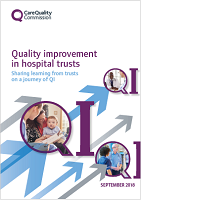‘Quality improvement in hospital trusts’ shares learning from acute, community and mental health trusts.

All had adopted and embedded Quality Improvement (QI) across their organisation. This is a systematic approach to improving service quality, efficiency and morale.
This report highlights what these trusts told us about their experiences of using QI.
The report is not a ‘how-to guide’. It uses the words of hospital staff to share learning with other trusts. Case studies aim to inspire those who may be considering adopting a QI approach.
What we did
The report is based on interviews with trust staff from all levels, local QI teams and patient groups. We visited the six trusts to see their QI in action.
We also spoke to members of our hospital inspection team. We reviewed inspection reports, trust board papers and local QI publications.
What we found
The approach taken by trusts to embed QI across their organisations was varied. But we found some common themes. Commitment from the board and senior leadership was crucial to ensuring success. Senior leaders acknowledged from the outset that QI would be a long-term journey. Everyone in the trust would need to make a commitment to it.
Models of improvement need leaders and frontline staff to work together. We saw barriers broken down between managers and clinicians, and providers and patients. There was a shared purpose to deliver better care to patients.
The report describes the various steps involved:
- identifying a need for a QI approach
- building the right skills and culture among staff
- applying specific QI techniques
It also highlights what trusts told us about the importance of involving patients in this work. There are examples of trusts working with patients and the local community to make beneficial changes.